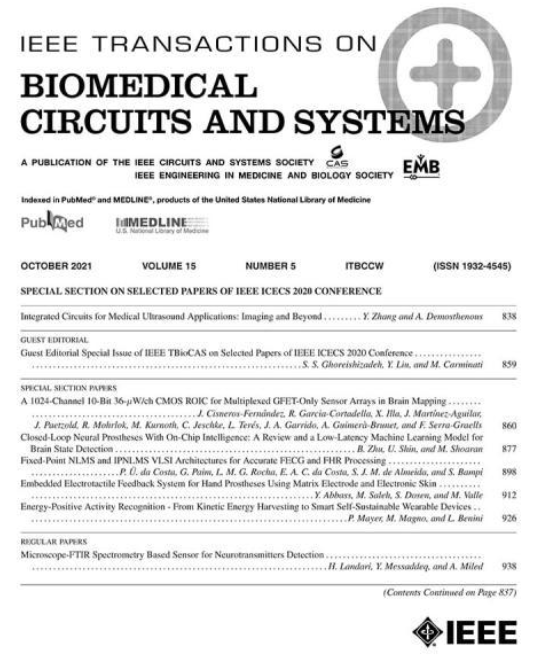基于谱功率和谱功率比的iEEG/sEEG低复杂度癫痫发作预测
IF 4.9
2区 医学
Q2 ENGINEERING, BIOMEDICAL
IEEE Transactions on Biomedical Circuits and Systems
Pub Date : 2016-06-01
DOI:10.1109/TBCAS.2015.2477264
引用次数: 167
摘要
预测癫痫发作是一个困难的问题,因为脑电图模式不是广泛意义上的静止,而是随着癫痫发作、电极与电极、患者之间的变化而变化。本文提出了一种新颖的患者特异性算法,用于预测癫痫患者的癫痫发作,从一个或两个单通道或双极通道的颅内或头皮脑电图(EEG)记录,具有低硬件复杂性。提取光谱功率特征并计算其比值。对于每个通道,每2秒提取8个绝对光谱功率、8个相对光谱功率和28个光谱功率比的44个特征,使用重叠50%的4秒窗口。然后使用两步特征选择以患者特定的方式对这些特征进行排序和选择。选择的特征通过二阶卡尔曼滤波进一步处理,然后输入到线性支持向量机(SVM)分类器中。该算法在Freiburg数据库中的颅内脑电图(iEEG)和MIT Physionet数据库中的头皮脑电图(sEEG)上进行了测试。弗莱堡的数据库在427小时的记录中记录了18名患者的80次癫痫发作。麻省理工学院的脑电图数据库包含了17名儿童在647小时的记录中发生的78次癫痫发作。结果表明,该算法对iEEG (Freiburg)数据库的检测灵敏度为100%,平均误报率(FPR)为0.0324 / h;对sEEG (MIT)数据库的检测灵敏度为98.68%,平均误报率为0.0465 / h。这些结果是通过留一交叉验证获得的,其中被测试的癫痫发作总是从训练集中被遗漏。该算法还具有较低的复杂度,因为可以使用FFT计算频谱功率。所提出的线性支持向量机的面积和功耗比径向基函数核支持向量机(RBF-SVM)分类器小2到3个数量级。此外,与使用RBF-SVM的系统相比,使用线性支持向量机的系统的总能耗降低了8%至23%。本文章由计算机程序翻译,如有差异,请以英文原文为准。
Low-Complexity Seizure Prediction From iEEG/sEEG Using Spectral Power and Ratios of Spectral Power
Prediction of seizures is a difficult problem as the EEG patterns are not wide-sense stationary and change from seizure to seizure, electrode to electrode, and from patient to patient. This paper presents a novel patient-specific algorithm for prediction of seizures in epileptic patients from either one or two single-channel or bipolar channel intra-cranial or scalp electroencephalogram (EEG) recordings with low hardware complexity. Spectral power features are extracted and their ratios are computed. For each channel, a total of 44 features including 8 absolute spectral powers, 8 relative spectral powers and 28 spectral power ratios are extracted every two seconds using a 4-second window with a 50% overlap. These features are then ranked and selected in a patient-specific manner using a two-step feature selection. Selected features are further processed by a second-order Kalman filter and then input to a linear support vector machine (SVM) classifier. The algorithm is tested on the intra-cranial EEG (iEEG) from the Freiburg database and scalp EEG (sEEG) from the MIT Physionet database. The Freiburg database contains 80 seizures among 18 patients in 427 hours of recordings. The MIT EEG database contains 78 seizures from 17 children in 647 hours of recordings. It is shown that the proposed algorithm can achieve a sensitivity of 100% and an average false positive rate (FPR) of 0.0324 per hour for the iEEG (Freiburg) database and a sensitivity of 98.68% and an average FPR of 0.0465 per hour for the sEEG (MIT) database. These results are obtained with leave-one-out cross-validation where the seizure being tested is always left out from the training set. The proposed algorithm also has a low complexity as the spectral powers can be computed using FFT. The area and power consumption of the proposed linear SVM are 2 to 3 orders of magnitude less than a radial basis function kernel SVM (RBF-SVM) classifier. Furthermore, the total energy consumption of a system using linear SVM is reduced by 8% to 23% compared to system using RBF-SVM.
求助全文
通过发布文献求助,成功后即可免费获取论文全文。
去求助
来源期刊

IEEE Transactions on Biomedical Circuits and Systems
工程技术-工程:电子与电气
CiteScore
10.00
自引率
13.70%
发文量
174
审稿时长
3 months
期刊介绍:
The IEEE Transactions on Biomedical Circuits and Systems addresses areas at the crossroads of Circuits and Systems and Life Sciences. The main emphasis is on microelectronic issues in a wide range of applications found in life sciences, physical sciences and engineering. The primary goal of the journal is to bridge the unique scientific and technical activities of the Circuits and Systems Society to a wide variety of related areas such as: • Bioelectronics • Implantable and wearable electronics like cochlear and retinal prosthesis, motor control, etc. • Biotechnology sensor circuits, integrated systems, and networks • Micropower imaging technology • BioMEMS • Lab-on-chip Bio-nanotechnology • Organic Semiconductors • Biomedical Engineering • Genomics and Proteomics • Neuromorphic Engineering • Smart sensors • Low power micro- and nanoelectronics • Mixed-mode system-on-chip • Wireless technology • Gene circuits and molecular circuits • System biology • Brain science and engineering: such as neuro-informatics, neural prosthesis, cognitive engineering, brain computer interface • Healthcare: information technology for biomedical, epidemiology, and other related life science applications. General, theoretical, and application-oriented papers in the abovementioned technical areas with a Circuits and Systems perspective are encouraged to publish in TBioCAS. Of special interest are biomedical-oriented papers with a Circuits and Systems angle.
 求助内容:
求助内容: 应助结果提醒方式:
应助结果提醒方式:


